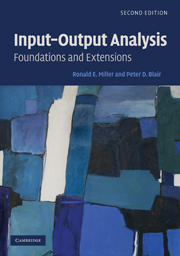Book contents
- Frontmatter
- Contents
- List of Figures
- List of Tables
- Preface
- 1 Introduction and Overview
- 2 Foundations of Input–Output Analysis
- 3 Input–Output Models at the Regional Level
- 4 Organization of Basic Data for Input–Output Models
- 5 The Commodity-by-Industry Approach in Input–Output Models
- 6 Multipliers in the Input–Output Model
- 7 Nonsurvey and Partial-Survey Methods: Fundamentals
- 8 Nonsurvey and Partial-Survey Methods: Extensions
- 9 Energy Input–Output Analysis
- 10 Environmental Input–Output Analysis
- 11 Social Accounting Matrices
- 12 Supply-Side Models, Linkages, and Important Coefficients
- 13 Structural Decomposition, Mixed and Dynamic Models
- 14 Additional Topics
- Appendix A Matrix Algebra for Input–Output Models
- Appendix B Reference Input–Output Tables for the United States (1919–2006)
- Appendix C Historical Notes on the Development of Leontief's Input–Output Analysis
- Author Index
- Subject Index
9 - Energy Input–Output Analysis
Published online by Cambridge University Press: 05 June 2012
- Frontmatter
- Contents
- List of Figures
- List of Tables
- Preface
- 1 Introduction and Overview
- 2 Foundations of Input–Output Analysis
- 3 Input–Output Models at the Regional Level
- 4 Organization of Basic Data for Input–Output Models
- 5 The Commodity-by-Industry Approach in Input–Output Models
- 6 Multipliers in the Input–Output Model
- 7 Nonsurvey and Partial-Survey Methods: Fundamentals
- 8 Nonsurvey and Partial-Survey Methods: Extensions
- 9 Energy Input–Output Analysis
- 10 Environmental Input–Output Analysis
- 11 Social Accounting Matrices
- 12 Supply-Side Models, Linkages, and Important Coefficients
- 13 Structural Decomposition, Mixed and Dynamic Models
- 14 Additional Topics
- Appendix A Matrix Algebra for Input–Output Models
- Appendix B Reference Input–Output Tables for the United States (1919–2006)
- Appendix C Historical Notes on the Development of Leontief's Input–Output Analysis
- Author Index
- Subject Index
Summary
Introduction
Leontief's original input–output framework (Leontief, 1936) conceived of industry production functions, which he frequently referred to as production “recipes,” as measured in physical units, such as specifying the technical coefficients in tons of coal or bushels of wheat, as inputs, required per dollar's worth of an industry's output or per ton of steel output. However, the data collection requirements and a number of other constraints rendered implementation of the framework in physical units too unwieldy, certainly at the time and even today to a lesser extent. Hence, the basic methodology for input–output analysis evolved, in both theory and application, through measuring all quantities in value terms with implicit fixed prices, as detailed in earlier chapters. Even late in his life, however, Professor Leontief continued to explore ways in which the framework could be implemented more widely in physical units rather than value terms (Leontief, 1989). A number of researchers, such as Duchin (1992), carried on with that work and continued to develop it.
The contributions of many researchers have extended the input–output framework incrementally in the direction of employing physical units and, in the process, have helped lay the groundwork for new research areas such as industrial ecology and ecological economics, which are topics addressed in more detail in Chapter 10. In addition, there have been substantial developments in related areas where public policy concerns have encouraged such development and data have been collected to help implement the framework.
- Type
- Chapter
- Information
- Input-Output AnalysisFoundations and Extensions, pp. 399 - 445Publisher: Cambridge University PressPrint publication year: 2009



